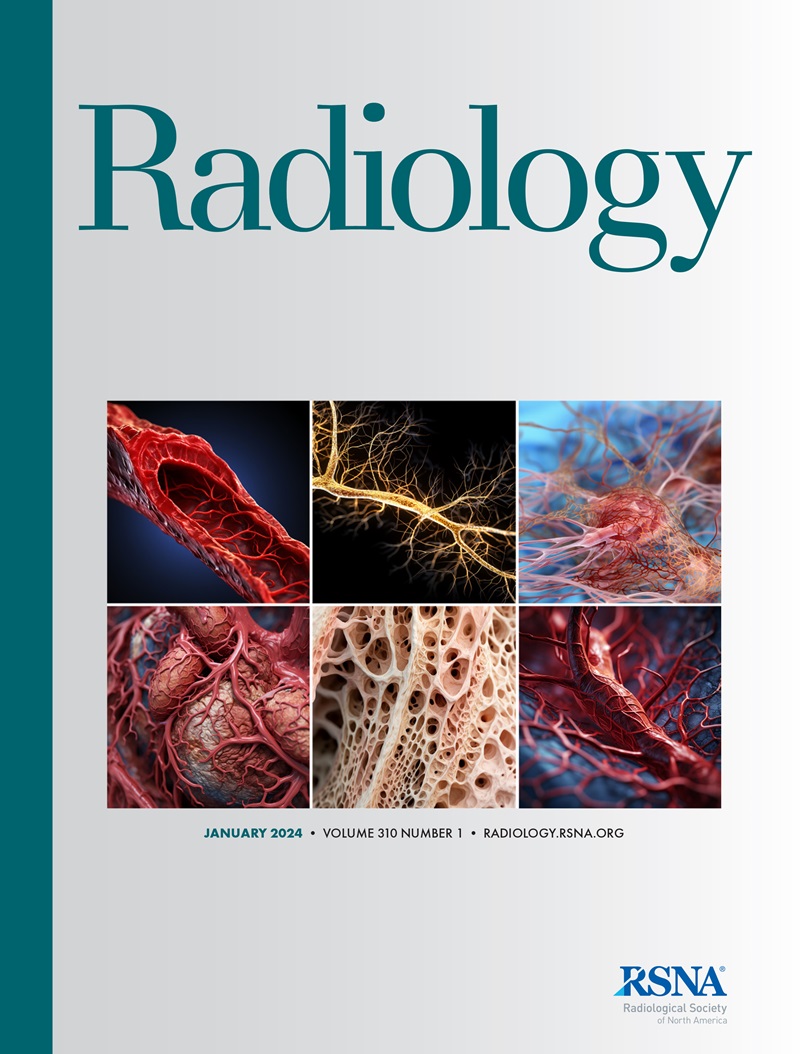求助PDF
{"title":"CT 心肌灌注和 CT-FFR 与侵入性 FFR 对冠状动脉疾病血液动力学相关性的对比。","authors":"Martin Soschynski, Roberto Storelli, Clara Birkemeyer, Muhammad Taha Hagar, Sebastian Faby, Chris Schwemmer, Fay M A Nous, Francesca Pugliese, Rozemarijn Vliegenthart, Christopher L Schlett, Konstantin Nikolaou, Patrick Krumm, Koen Nieman, Fabian Bamberg, Christoph P Artzner","doi":"10.1148/radiol.233234","DOIUrl":null,"url":null,"abstract":"<p><p>Background CT-derived fractional flow reserve (CT-FFR) and dynamic CT myocardial perfusion imaging enhance the specificity of coronary CT angiography (CCTA) for ruling out coronary artery disease (CAD). However, evidence on comparative diagnostic value remains scarce. Purpose To compare the diagnostic accuracy of CCTA plus CT-FFR, CCTA plus CT perfusion, and sequential CCTA plus CT-FFR and CT perfusion for detecting hemodynamically relevant CAD with that of invasive angiography. Materials and Methods This secondary analysis of a prospective study included patients with chest pain referred for invasive coronary angiography at nine centers from July 2016 to September 2019. CCTA and CT perfusion were performed with third-generation dual-source CT scanners. CT-FFR was assessed on-site. Independent core laboratories analyzed CCTA alone, CCTA plus CT perfusion, CCTA plus CT-FFR, and a sequential approach involving CCTA plus CT-FFR and CT perfusion for the presence of hemodynamically relevant stenosis. Invasive coronary angiography with invasive fractional flow reserve was the reference standard. Diagnostic accuracy metrics and the area under the receiver operating characteristic curve (AUC) were compared with the Sign test and DeLong test. Results Of the 105 participants (mean age, 64 years ± 8 [SD]; 68 male), 49 (47%) had hemodynamically relevant stenoses at invasive coronary angiography. CCTA plus CT-FFR and CCTA plus CT perfusion showed no evidence of a difference for participant-based sensitivities (90% vs 90%, <i>P</i> > .99), specificities (77% vs 79%, <i>P</i> > .99) and vessel-based AUCs (0.84 [95% CI: 0.77, 0.91] vs 0.83 [95% CI: 0.75, 0.91], <i>P</i> = .90). Both had higher participant-based specificity than CCTA alone (54%, both <i>P</i> < .001) without evidence of a difference in sensitivity between CCTA (94%) and CCTA plus CT perfusion (<i>P</i> = .50) or CCTA plus CT-FFR (<i>P</i> = .63). The sequential approach combining CCTA plus CT-FFR with CT perfusion achieved higher participant-based specificity than CCTA plus CT-FFR (88% vs 77%, <i>P</i> = .03) without evidence of a difference in participant-based sensitivity (88% vs 90%, <i>P</i> > .99) and vessel-based AUC (0.85 [95% CI: 0.77, 0.93], <i>P</i> = .78). Compared with CCTA plus CT perfusion, the sequential approach showed no evidence of a difference in participant-based sensitivity (<i>P</i> > .99), specificity (<i>P</i> = .06), or vessel-based AUC (<i>P</i> = .54). Conclusion There was no evidence of a difference in diagnostic accuracy between CCTA plus CT-FFR and CCTA plus CT perfusion for detecting hemodynamically relevant CAD. A sequential approach combining CCTA plus CT-FFR with CT perfusion led to improved participant-based specificity with no evidence of a difference in sensitivity compared with CCTA plus CT-FFR. ClinicalTrials.gov registration no.: NCT02810795 © RSNA, 2024 <i>Supplemental material is available for this article.</i> See also the editorial by Sinitsyn in this issue.</p>","PeriodicalId":20896,"journal":{"name":"Radiology","volume":null,"pages":null},"PeriodicalIF":12.1000,"publicationDate":"2024-08-01","publicationTypes":"Journal Article","fieldsOfStudy":null,"isOpenAccess":false,"openAccessPdf":"","citationCount":"0","resultStr":"{\"title\":\"CT Myocardial Perfusion and CT-FFR versus Invasive FFR for Hemodynamic Relevance of Coronary Artery Disease.\",\"authors\":\"Martin Soschynski, Roberto Storelli, Clara Birkemeyer, Muhammad Taha Hagar, Sebastian Faby, Chris Schwemmer, Fay M A Nous, Francesca Pugliese, Rozemarijn Vliegenthart, Christopher L Schlett, Konstantin Nikolaou, Patrick Krumm, Koen Nieman, Fabian Bamberg, Christoph P Artzner\",\"doi\":\"10.1148/radiol.233234\",\"DOIUrl\":null,\"url\":null,\"abstract\":\"<p><p>Background CT-derived fractional flow reserve (CT-FFR) and dynamic CT myocardial perfusion imaging enhance the specificity of coronary CT angiography (CCTA) for ruling out coronary artery disease (CAD). However, evidence on comparative diagnostic value remains scarce. Purpose To compare the diagnostic accuracy of CCTA plus CT-FFR, CCTA plus CT perfusion, and sequential CCTA plus CT-FFR and CT perfusion for detecting hemodynamically relevant CAD with that of invasive angiography. Materials and Methods This secondary analysis of a prospective study included patients with chest pain referred for invasive coronary angiography at nine centers from July 2016 to September 2019. CCTA and CT perfusion were performed with third-generation dual-source CT scanners. CT-FFR was assessed on-site. Independent core laboratories analyzed CCTA alone, CCTA plus CT perfusion, CCTA plus CT-FFR, and a sequential approach involving CCTA plus CT-FFR and CT perfusion for the presence of hemodynamically relevant stenosis. Invasive coronary angiography with invasive fractional flow reserve was the reference standard. Diagnostic accuracy metrics and the area under the receiver operating characteristic curve (AUC) were compared with the Sign test and DeLong test. Results Of the 105 participants (mean age, 64 years ± 8 [SD]; 68 male), 49 (47%) had hemodynamically relevant stenoses at invasive coronary angiography. CCTA plus CT-FFR and CCTA plus CT perfusion showed no evidence of a difference for participant-based sensitivities (90% vs 90%, <i>P</i> > .99), specificities (77% vs 79%, <i>P</i> > .99) and vessel-based AUCs (0.84 [95% CI: 0.77, 0.91] vs 0.83 [95% CI: 0.75, 0.91], <i>P</i> = .90). Both had higher participant-based specificity than CCTA alone (54%, both <i>P</i> < .001) without evidence of a difference in sensitivity between CCTA (94%) and CCTA plus CT perfusion (<i>P</i> = .50) or CCTA plus CT-FFR (<i>P</i> = .63). The sequential approach combining CCTA plus CT-FFR with CT perfusion achieved higher participant-based specificity than CCTA plus CT-FFR (88% vs 77%, <i>P</i> = .03) without evidence of a difference in participant-based sensitivity (88% vs 90%, <i>P</i> > .99) and vessel-based AUC (0.85 [95% CI: 0.77, 0.93], <i>P</i> = .78). Compared with CCTA plus CT perfusion, the sequential approach showed no evidence of a difference in participant-based sensitivity (<i>P</i> > .99), specificity (<i>P</i> = .06), or vessel-based AUC (<i>P</i> = .54). Conclusion There was no evidence of a difference in diagnostic accuracy between CCTA plus CT-FFR and CCTA plus CT perfusion for detecting hemodynamically relevant CAD. A sequential approach combining CCTA plus CT-FFR with CT perfusion led to improved participant-based specificity with no evidence of a difference in sensitivity compared with CCTA plus CT-FFR. ClinicalTrials.gov registration no.: NCT02810795 © RSNA, 2024 <i>Supplemental material is available for this article.</i> See also the editorial by Sinitsyn in this issue.</p>\",\"PeriodicalId\":20896,\"journal\":{\"name\":\"Radiology\",\"volume\":null,\"pages\":null},\"PeriodicalIF\":12.1000,\"publicationDate\":\"2024-08-01\",\"publicationTypes\":\"Journal Article\",\"fieldsOfStudy\":null,\"isOpenAccess\":false,\"openAccessPdf\":\"\",\"citationCount\":\"0\",\"resultStr\":null,\"platform\":\"Semanticscholar\",\"paperid\":null,\"PeriodicalName\":\"Radiology\",\"FirstCategoryId\":\"3\",\"ListUrlMain\":\"https://doi.org/10.1148/radiol.233234\",\"RegionNum\":1,\"RegionCategory\":\"医学\",\"ArticlePicture\":[],\"TitleCN\":null,\"AbstractTextCN\":null,\"PMCID\":null,\"EPubDate\":\"\",\"PubModel\":\"\",\"JCR\":\"Q1\",\"JCRName\":\"RADIOLOGY, NUCLEAR MEDICINE & MEDICAL IMAGING\",\"Score\":null,\"Total\":0}","platform":"Semanticscholar","paperid":null,"PeriodicalName":"Radiology","FirstCategoryId":"3","ListUrlMain":"https://doi.org/10.1148/radiol.233234","RegionNum":1,"RegionCategory":"医学","ArticlePicture":[],"TitleCN":null,"AbstractTextCN":null,"PMCID":null,"EPubDate":"","PubModel":"","JCR":"Q1","JCRName":"RADIOLOGY, NUCLEAR MEDICINE & MEDICAL IMAGING","Score":null,"Total":0}
引用次数: 0
引用
批量引用


